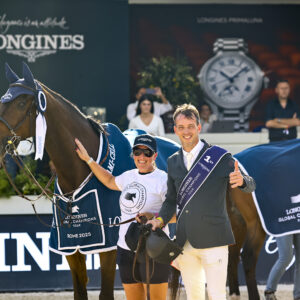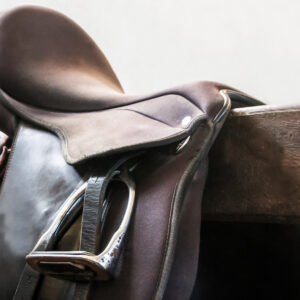To the untrained eye, lunging looks like an exercise of chasing the horse around in seemingly never-ending circles. I’ve often heard questions posed by new equestrians, horse husbands and non-horsey friends like—
“Don’t they get dizzy?”
“Why not just ride?”
“What’s the point of this whole thing?”
And, if we’re being totally honest with ourselves, how many of us can sit down and draw out the benefits of lunging beyond “My trainer told me I needed to lunge”? And if your answer is along the lines of ensuring you don’t die when you get on, I implore you to really think about how and why you’re lunging and read on.
The reasons we lunge should generally fall into a few broad categories:
- Engage the mind
- Warm up and supple the body
- Introduce new ideas sans rider
- Practice quality gaits
You may notice one thing is missing in that list. As educated equestrians, we should never be lunging with the intention of wearing a horse out.
Now, before you get your pitchforks out and hunt me down, give me a running start and read the rest of the article first.
When you lunge with the intention of wearing a horse out, you go into the lunging session thinking backwards. A fresh horse can be dangerous, that’s for sure, but when you put a hot-headed horse out on the lunge and just let them run to “get it out of their system” before you hop on, you’re actually putting yourself in more danger. By wearing out the horse’s body, one important piece of the horse is being overlooked—the mind.
Think about is this way…Your kids have been out of school for a few days and cooped up in the house due to snow. On the first nice day, you are so ready to get them out of the house, so you tell them to run in circles around the house for ten minutes before coming inside to do homework. When they come inside to their homework, huffing and puffing, they are in no frame of mind to learn. They’re frazzled from all the cooped up energy spent all at once and now you’re asking them to change gears entirely and start doing math (the kind with numbers!). Good luck, mom.

(Flickr/ctax)
This is precisely what you’re doing with your OTTB that’s hasn’t been turned out for a few days when you put them out on the lunge, bucking and running wild. You may have a sweaty, tired horse when you’re done but the horse’s mind is still going a mile a minute. A tired body paired with an all too energetic mind results in a horse that is in no state to learn and you’re about to hop on their back in that stressed out state. While your horse may not have the energy to buck you off anymore, you also aren’t doing yourself any favors when you try to introduce the shoulder-in for the first time because their mind isn’t ready to buckle down and pay attention yet. So, next time try to re-frame your lunging session to meet one of these 4 categories.
Engage the mind
Engaging the mind is the exercise we should practice instead of wearing out the body. To engage the mind, we use lunging to prepare the horse for learning. This type of lunging focuses and prepares the horse, instead of allowing him to think about how all of his friends are outside and how all he wants to do is run, and buck, and run, run, run! There is no galloping around in senseless circles, but rather a quiet and encouraging leader asking for a series of well-timed transitions and changes of direction.

(Flickr/akras)
What you’re looking for here is a lowered head instead of the snorting, raised head of the crazy stallion you took out of the stall. You’re looking for the inside ear trained on you in the center and maybe a few licks and chews of the jaw when the horse tells you they’re ready to learn and totally focused on whatever you ask next.
Warm up and supple the body
This type of lunging can be used to spot any stiffness and lameness within gaits. Additionally, lunging with the intention of warming up muscles ensures the horse is comfortable and ready to accept a rider. This is a great next step after you’ve engaged the mind. Practicing transitions within gaits, more advanced transitions, like halt-to-trot or walk-to-canter, and different sizes of circles on the lunge will help your horse become more supple and ready to work from a physical, instead of a mental, standpoint.
Introduce new ideas sans rider
A very important type of lunging is introducing new ideas without a rider. Using lunging in this way is a basic element of lunging in training. Whether it’s teaching a horse to accept a saddle or bridle, teaching a basic collection or lengthen within a gait or any number of new ideas, lunging for this purpose allows the horse to take the time to understand this new concept without worrying what the heck the rider is doing up there.

(flickr.com/Thowra_uk)
This is also a great time to introduce scary objects like a tarp, or test the horse’s ability at a new discipline, like jumping. It allows the horse to react however it needs to without putting you in harm’s way.
Practice quality gaits
Practicing quality gaits in lunging is one that I use regularly, but I feel is generally overlooked with riders. When lunging, you have two great aids at your disposal and you can use those to your advantage and help your horse practice quality gaits instead of the strung-out gaits we see too often when lunging.
The lunge whip is your driving aid, like your leg would be when riding, and your hand on the lunge line is just like your hand on the reins. With a driving aid telling the horse to move forward and a rein aid used as a series of well-timed, rebalancing half-halts, you can help your horse truly find its balance, step under itself and find that engaged walk, trot or canter your trainer tells you is possible. The great benefit of this type of lunging is for you as the rider, being able to see those gaits from the ground, and for the horse being able to find their balance and figure out where their feet are before adding the rider’s weight to the mix.
So, next time you clip on that lunge line, think to yourself “What is my purpose here?” and ensure you’re lunging for the benefit of your horse. Your horse’s body and mind will thank you.

 January 11, 2016
January 11, 2016 

























